Free to share the latest updated Fortinet NSE7_EFW-6.2 exam questions and answers, all exam questions come from the exam laboratory and real-question cracking. All Fortinet NSE7_EFW-6.2 exam questions shared on this site are provided by leads4pass exam experts. You can get the latest NSE7_EFW-6.2 dumps, NSE7_EFW-6.2 pdf, NSE7_EFW-6.2 exam questions here. Get the complete NSE7_EFW-6.2 dumps exam path: https://www.leads4pass.com/nse7_efw-6-2.html (Q&A: 102). All Fortinet NSE7_EFW-6.2 exam questions have been updated and the answers have been corrected! Make sure your exam questions are true and valid to help you pass the first exam!
[Fortinet NSE7_EFW-6.2 exam pdf] Fortinet NSE7_EFW-6.2 exam PDF uploaded from google drive, online download provided by the latest update of leads4pass:
https://drive.google.com/file/d/1joFHhfG89seSP7oUZhhT4A4EBGufREh9/
Latest update Fortinet NSE7_EFW-6.2 exam questions and answers online practice test
QUESTION 1
A FortiGate is rebooting unexpectedly without any apparent reason. What troubleshooting tools could an administrator
use to get more information about the problem? (Choose two.)
A. Firewall monitor.
B. Policy monitor.
C. Logs.
D. Crashlogs.
Correct Answer: CD
QUESTION 2
What is the purpose of an internal segmentation firewall (ISFW)?
A. It inspects incoming traffic to protect services in the corporate DMZ.
B. It is the first line of defense at the network perimeter.
C. It splits the network into multiple security segments to minimize the impact of breaches.
D. It is an all-in-one security appliance that is placed at remote sites to extend the enterprise network.
Correct Answer: C
ISFW splits your network into multiple security segments. They serve as a breached container from attacks that come
from inside.
QUESTION 3
An administrator added the following IPsec VPN to a FortiGate configuration: config VPN IPsec phase -interface
edit “RemoteSite” set type dynamic set interface “portl” set mode main set psksecret ENC LCVkCiK2E2PhVUzZe next
end config VPN IPsec phase2-interface edit “RemoteSite” set phasel name “RemoteSite” set proposal 3des-sha256 next
end, However, the phase 1 negotiation is failing. The administrator executed the IKF real-time debug while attempting
the IPsec connection. The output is shown in the exhibit.
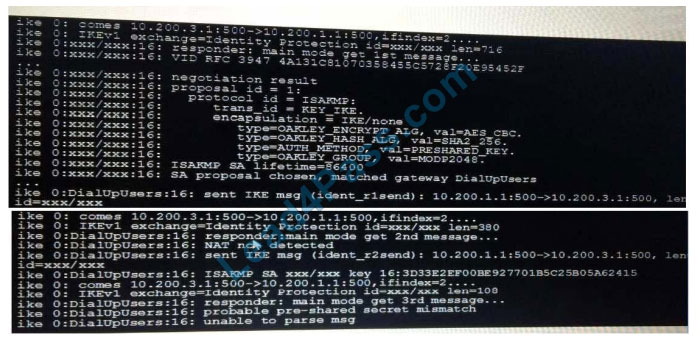
What is causing the IPsec problem in phase 1?
A. The incoming IPsec connection is matching the wrong VPN configuration
B. The phrase-1 mode must be changed to aggressive
C. The pre-shared key is wrong
D. NAT-T settings do not match
Correct Answer: C
QUESTION 4
How does FortiManager handle FortiGuard requests from FortiGate devices, when it is configured as a local FDS?
A. FortiManager can download and maintain local copies of FortiGuard databases.
B. FortiManager supports only FortiGuard push to managed devices.
C. FortiManager will respond to update requests only if they originate from a managed device.
D. FortiManager does not support rating requests.
Correct Answer: A
QUESTION 5
Which the following events can trigger the election of a new primary unit in a HA cluster? (Choose two.)
A. Primary unit stops sending HA heartbeat keepalives.
B. The FortiGuard license for the primary unit is updated.
C. One of the monitored interfaces in the primary unit is disconnected.
D. A secondary unit is removed from the HA cluster.
Correct Answer: AC
QUESTION 6
Examine the output of the `diagnose sys session list expectation\\’ command shown in the exhibit; then answer the
question below.
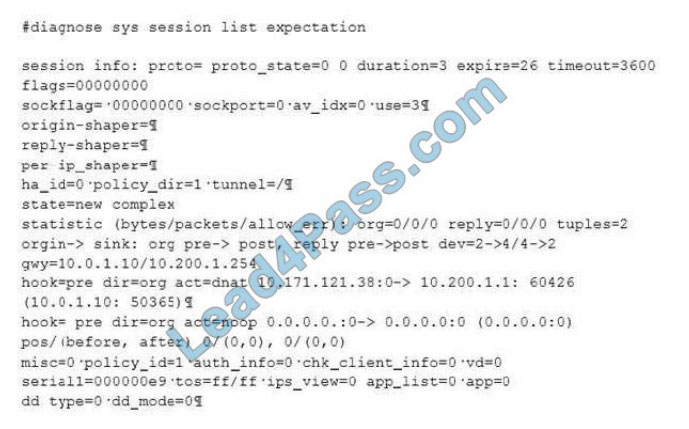
Which statement is true regarding the session in the exhibit?
A. It was created by the FortiGate kernel to allow push updates from FotiGuard.
B. It is for management traffic terminating at the FortiGate.
C. It is for traffic originated from the FortiGate.
D. It was created by a session helper or ALG.
Correct Answer: D
QUESTION 7
View the central management configuration shown in the exhibit, and then answer the question below.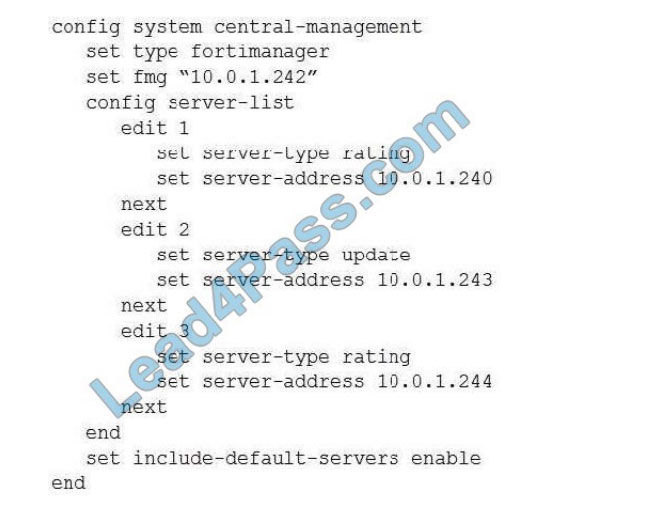
Which server will FortiGate choose for antivirus and IPS updates if 10.0.1.243 is experiencing an outage?
A. 10.0.1.240
B. One of the public FortiGuard distribution servers
C. 10.0.1.244
D. 10.0.1.242
Correct Answer: B
QUESTION 8
Examine the partial output from the IKE real-time debug shown in the exhibit; then answer the question
below.
Why didn\\’t the tunnel come up?
A. IKE mode configuration is not enabled in the remote IPsec gateway.
B. The remote gateway\\’s Phase-2 configuration does not match the local gateway\\’s phase-2 configuration.
C. The remote gateway\\’s Phase-1 configuration does not match the local gateway\\’s phase-1 configuration.
D. One IPsec gateway is using the main mode, while the other IPsec gateway is using the aggressive mode.
Correct Answer: C
QUESTION 9
An administrator wants to capture ESP traffic between two FortiGates using the built-in sniffer. If the administrator
knows that there is no NAT device located between both FortiGates, what command should the administrator execute?
A. diagnose sniffer packet any `UDP port 500\\’
B. diagnose sniffer packet any `UDP port 4500\\’
C. diagnose sniffer packet any `esp\\’
D. diagnose sniffer packet any `UDP port 500 or UDP port 4500\\’
Correct Answer: C
Capture IKE Traffic without NAT:
diagnose sniffer packet `host and UDP port 500\\’
————————————————————————— Capture ESP Traffic without NAT:
diagnose sniffer packet any `host and esp\\’
————————————————————————— Capture IKE and ESP with NAT-T:
diagnose sniffer packet any `host and (UDP port 500 or UDP port 4500)\\’
QUESTION 10
Which two tasks are automated using the Install Wizard on FortiManager? (Choose two.)
A. Preview pending configuration changes for managed devices.
B. Add devices to FortiManager.
C. Import policy packages from managed devices.
D. Install configuration changes to managed devices.
E. Import interface mappings from managed devices.
Correct Answer: AD
https://help.fortinet.com/fmgr/50hlp/56/5-6-2/FortiManager_Admin_Guide/1000_Device%
20Manager/1200_install_to%20devices/0400_Install% 20wizard-device%20settings.htm There are 4 main wizards: Add
Device: is used to add devices to central management and import their configurations. Install: is used to install
configuration changes from Device Manager or Policies and Objects to the managed devices. It allows you to preview
the changes and, if the administrator doesn\\’t agree with the changes, cancel and modify them. Import policy: is used to
import interface mapping, policy database, and objects associated with the managed devices into a policy package
under the Policy and Object tab. It runs with the Add Device wizard by default and may be run at any time from the
managed device list. Re-install policy: This is used to perform a quick install of the policy package. It doesn\\’t gives the ability
to preview the changes that will be installed to the managed device.
QUESTION 11
Which statements about bulk configuration changes using FortiManager CLI scripts are correct? (Choose two.)
A. When executed on the Policy Package, ADOM database, changes are applied directly to the managed FortiGate.
B. When executed on the Device Database, you must use the installation wizard to apply the changes to the managed
FortiGate.
C. When executed on the All FortiGate in ADOM, changes are automatically installed without creating a new revision
history.
D. When executed on the Remote FortiGate directly, administrators do not have the option to review the changes prior
to installation.
Correct Answer: BD
CLI scripts can be run in three different ways: Device Database: By default, a script is executed on the device database.
It is recommended you run the changes on the device database (default setting), as this allows you to check what
configuration changes you will send to the managed device. Once scripts are run on the device database, you can
install these changes to a managed device using the installation wizard. Policy Package, ADOM database: If a script
contains changes related to ADOM level objects and policies, you can change the default selection to run on Policy
Package, ADOM database and can then be installed using the installation wizard. Remote FortiGate directly (through
CLI): A script can be executed directly on the device and you don\\’t need to install these changes using the installation
wizard. As the changes are directly installed on the managed device, no option is provided to verify and check the
configuration changes through FortiManager prior to executing them.
QUESTION 12
View the exhibit, which contains the output of a real-time debug, and then answer the question below.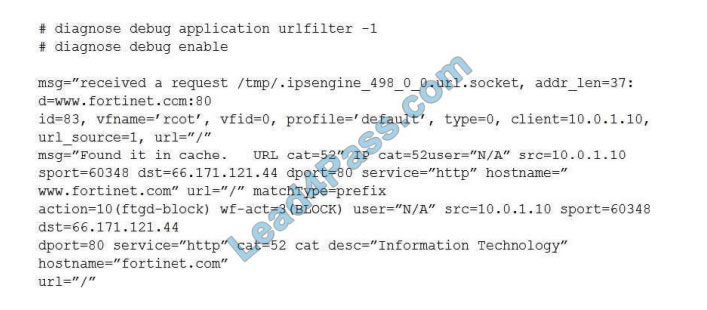
Which of the following statements is true regarding this output? (Choose two.)
A. This web request was inspected using the root web filter profile.
B. FortiGate found the requested URL in its local cache.
C. The requested URL belongs to category ID 52.
D. The web request was allowed by FortiGate.
Correct Answer: BC
QUESTION 13
An administrator has configured a FortiGate device with two VDOMs: root and internal. The administrator has also
created an inter-VDOM link that connects both VDOMs. The objective is to have each VDOM advertise some routes to
the other VDOM via OSPF through the inter-VDOM link. What OSPF configuration settings must match in both VDOMs
to have the OSPF adjacency successfully forming? (Choose three.)
A. Router ID.
B. OSPF interface area.
C. OSPF interface cost.
D. OSPF interface MTU.
E. Interface subnet mask.
Correct Answer: BDE
and get the complete NSE7_EFW-6.2 exam dumps path. For information about NSE7_EFW-6.2 Dumps from leads4pass (including PDF and VCE), please visit: https://www.leads4pass.com/nse7_efw-6-2.html (102 Q&A)
ps.
Get free Fortinet NSE7_EFW-6.2 dumps PDF online: https://drive.google.com/file/d/1joFHhfG89seSP7oUZhhT4A4EBGufREh9/
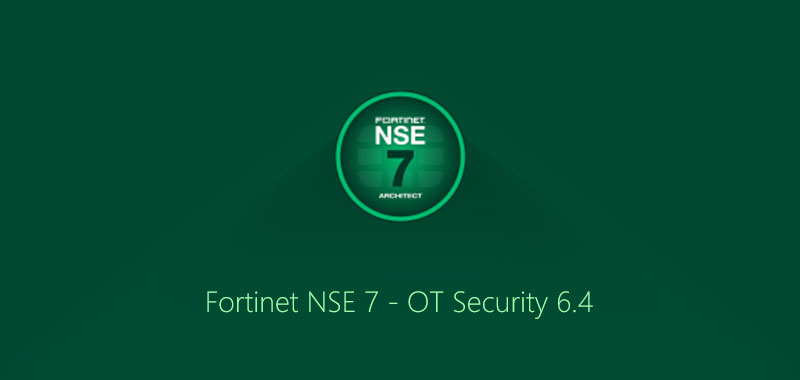
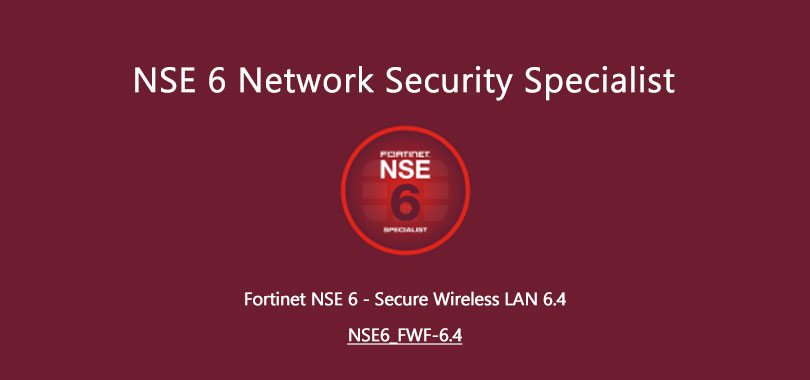
Comments are closed.